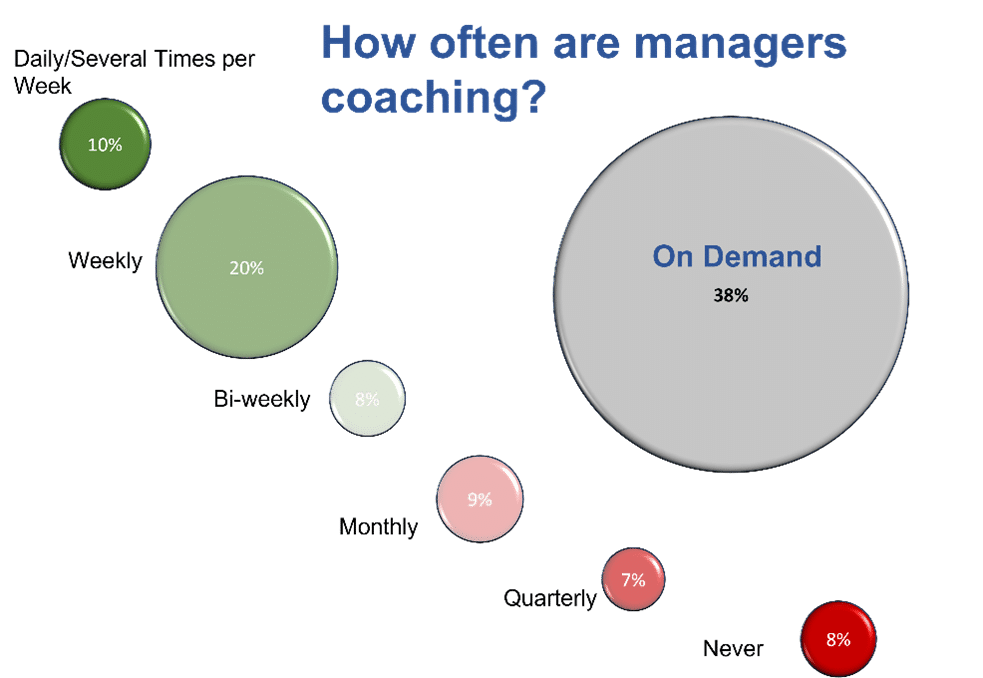What makes sales teams win more deals?
Are they just better or more elite? Nope. Turns out that sales enablement plays a key role in results.
Sales enablement gives your sales reps the leadership, support, technology, content, and processes they need to close more deals consistently. It’s also how you turn 50% of your average performers into elite sales reps.
Let’s take a closer look at the five components of sales enablement.
- Sales support: support is a broad category that includes training, workflows, escalation, feedback, and tactical support (e.g., your customer wants to modify the terms and conditions of your deal, and you need management guidance/approval).
- Sales management and leadership: this points to a variety of actions – your managers outline sales strategy for specific accounts (i.e., set the budget early to disqualify poor candidates), set general and specific sales goals (i.e., generate $35K in new sales, per rep by the end of Q2), and track sales performance at an individual and group level.
- Sales technology: your sales team has a technology platform that manages workflows, provides structure and guidance, and ensures tasks are completed to standard. If done well, your technology stack will minimize administration and utilization costs, increasing your sales team’s productivity. Your technology stack includes lead forms, lead qualification, prospecting, email, and CRM management tools.
- Sales content: this type of information is designed to persuade customers to buy. It’s not top-of-funnel content (ToFu); it’s content that’s focused on one thing – closing. Marketing creates educational content; this attracts subscribers and prospects. Sales rely on informational content – content that’s designed.
- Sales process: elite sales reps clearly know what to do and when. There’s no confusion about the tasks that need to be done and no wondering about workflows. Contrast this with the majority of sales organizations. Sales reps are expected to prospect for leads and work with their contacts independently. With no process in place, it’s no wonder sales are struggling.
Remember, 3 out of 4 sales reps are weak and ineffective. These salespeople fail to meet the minimum standards. Are the majority of sales reps terrible at selling and incapable of performance improvement?
Are sales managers wasting their time with most of their reps?
How to Use Sales Enablement to Improve Performance
Research tells us that the performance of weak and ineffective sales reps can be improved with sales enablement.
It enables you to:
- Communicate expectations and requirements. This goes way past quota requirements. If you’re communicating expectations, you’re giving your reps specifics (e.g., you’ll receive a minimum of 270 leads a month, and you’re expected to close 25 to 50 of those leads each month).
- You can set benchmarks and performance standards. For example, you should send a minimum of 20 email pitches per day or call 20 businesses each week. Benchmarks and standards are important because it establishes a performance hierarchy.
- You can identify failure points. With your performance standards in place, your sales managers can quickly identify the processes that need to be changed, the salespeople who need training, the customers who need to be disqualified, and the deals that need to be let go.
- Your technology stack will quantify what works and what doesn’t. For example, if you’re using a CRM, you’ll have detailed information on the deals in progress and the salespeople on those deals. If the C-suite is pushing an initiative customers aren’t interested in, your technology stack will give you the hard data you need to find what works. Are your elite sales reps closing twice as many deals as your average reps? Your technology stack will provide you with the data you need to grow.
Good sales enablement informs your strategy. You’ll be able to create an adaptable sales strategy that produces consistent gains over time. That is, if the right people are responsible for sales enablement.
Who’s Responsible for Sales Enablement?
While sales managers take the lead role, sales enablement is a team effort.
Let’s take a look at the departments/roles involved in the enablement process.
- Customer service: support teams communicate with customers; they know (a.) why customers leave, (b.) what their biggest complaints are, and (c.) where to find the failure points in your products and services.
- Marketing: they’re responsible for attracting attention, creating visibility, and generating conversions. Your marketing team can create a list of your best-performing content and campaigns (via analytics). They have detailed information on your customers, including demographics, psychographics, ethnographies, etc.
- Sales: your sales team sees customers on the front-end. This means you have in-depth knowledge of your customer’s desires, goals, fears, and frustrations. You also have an in-depth understanding of customer objections, risks, and expectations.
- Product management: are your products and services demonstrably better or worse than a competitor’s offering? It’s a difficult thing for many organizations to be honest about. It’s easier for sales teams to face facts; it’s not so easy for product managers or service professionals. One perspective matters above all – your customers.
- Accounting: yes, accounting, you’ll want to reach out to the accounting team for specific financial data. Which products generate the greatest profit margins? The largest sales commissions? The most revenue? Which products or services are viewed as important vanity purchases that management wants to push? It’s important that you make a list of the metrics and KPIs that are relevant to sales.
Can you see what’s happening? If your organization struggles with turf wars, silos, and internal politics, you’ll find sales enablement is a challenging and messy ordeal. Winning deals in this environment will be messy and complex.
What if you have the kind of support you need? How do you use sales enablement to win more deals?
Using Sales Enablement to Win More Deals
At its core, sales enablement is about information gathering.
Here’s a short list of the information you’ll need to make it work.
- Important processes and workflows sales reps need to follow
- The benchmarks, metrics, and KPIs you’ll use to measure success
- The expectations sales reps are asked to meet
- What’s happening (or not happening) in your deals
- What you’re doing now
- What you need to do (daily, weekly, monthly, etc.)
- What’s working well (or not working well)
- What you need to disqualify prospects quickly
- What prospects need to make a decision
- What your sales reps need to overcome objections and close the sale
- The goals being met and the ones that are not
- The training your sales reps need to improve performance
You’re addressing these concerns in a way that makes success a repeatable process. Let’s take a closer look at the components of sales enablement (e.g., leadership, support, technology, content, and processes) to break things down further.
Win More Deals with Sales Processes
Here’s a starter list of the essential sales processes your team should have in place.
Feel free to customize this on an as-needed basis.
- Workflows to build product and service knowledge
- Research processes to identify ideal prospects
- Prospecting and lead qualification workflows
- Lead nurturing and follow-up workflows
- Needs analysis workflows
- Sales call frameworks
- Presentation, pitch, and demo frameworks
- Negotiation workflows and closing frameworks
- Sales training frameworks
- Customer onboarding workflows
These workflows, processes, and frameworks give your sales team the clarity and direction they need to be onboarded quickly and immediately productive.
Win More Deals with Sales Technology
Which tools should be in your sales team’s technology stack?
Believe it or not, you already have the answer to this question. You need sales tools that:
- Analyze individual rep and team performance. These tools measure your team’s performance against essential KPIs, metrics, and benchmarks. These tools include Tableau, Power BI, Pipeline CRM, Zoho Analytics, and Looker by Google Cloud
- Host your team’s sales content so your body of knowledge is centralized and always accessible to your team
- Manages your sales funnel on an individual and team basis
- Onboard new customers and provides sales automations to minimize administrative headaches and increase productivity
- Manage the customer relationship, tracking the conversations and activities that take place during the deal lifecycle. Pipeline CRM is a great example of a platform that lets you track every stage.
- Score leads, allowing your team to focus on ideal prospects who are ready to buy first. Tools like Experium and 6Sense are great examples of this
- Provide email outreach and management to track down email addresses, handle messages, etc. Examples include Hunter.io, Outlook/Gmail, etc.
- Automate/semi-automate key tasks. These productivity and administrative tools handle essential tasks like appointment setting, meetings, proposal and quote generation, and document signing. Examples include Calendly, Adobe Sign, and Formstack
- Maximize customer success, helping you minimize buyer’s remorse, maintain open lines of communication, and provide onboarding support. Examples include Intercom, Catalyst, and Typeform
- Integrate all of your data, enabling your tools to talk to each other and share data freely. Data integration tools include Zapier and Oracle Data Integration
Are you seeing the value of the tools in your technology stack?
If you have the right tools in your stack, you can automate or semi-automate these important to-dos, ensuring your sales team has everything they need to perform at the standard you’ve set.
Win More Deals with Sales Content
What kind of sales content do you need to close your deals? The various types of sales content include:
- Battlecards (head-to-head competitor comparisons)
- Case studies
- Proposals and quotes
- Objections
- Testimonials and reviews
- Company policies
- Warranties, guarantees, and risk reversals
- Achievements, awards, and recognition
- Price lists
- Fact sheets/data sheets
- Comparison charts
- Problems
- Email campaigns (broadcast and autoresponder sequences)
- Informative blog posts
- Print material (collateral, brochures, catalogs, etc.)
- Whitepapers, eBooks, playbooks, and guides
This list isn’t comprehensive, but it is a great place to start.
If your sales reps have the sales content they need, they have the information they need to close more sales in less time. They can share content with customers, using it as a cheat sheet for customer feedback or as a bargaining tool.
Win More Deals with Sales Support
Sales support refers to activities that help your sales team boost productivity, improve sales performance, and close more deals. Here are some common tasks for sales
- Automate, outsource, delegate, simplify, or replace any sales tasks that take sales reps away from prospects
- Qualify initial prospects, then filter them down to sales-qualified leads (SQLs).
- Administrative tasks (e.g., scheduling sales training or continuing education)
- Acting as a sales rep’s lifeline when they’re working to close a deal
- Monitoring customer accounts for upselling, cross-selling, and down-selling opportunities
It’s all about your focus.
If your sales reps aren’t spending most of their time in front of your prospects, they need ongoing sales support. Great sales support works for sales reps, taking reasonable steps to keep them in front of prospects and selling your products and services.
Win more Deals with Sales Leadership
Sales leadership sounds like such a cliché. It’s actually a necessary part of the sales process; neglect sales leadership, and your team will underperform. According to the Objective Management Group, “Sales managers who devote at least 50% of their time to coaching salespeople have sales people whose sales percentile score is 28% higher than those managers who devoted little to none of their time coaching.” To add, “sales managers who devote at least 50% of their time to coaching have teams that score 13% better in Qualifying and 24% better in Closing than those whose sales managers rarely coach.”
Pretty significant, right?
So how often are sales managers coaching (leading) their sales teams?
“Coaching that occurs on a daily basis or multiple times per week produces notable gains for salespeople in a number of areas. These improvements are seen in both a salesperson’s attitude (i.e., responsibility and motivation) and tactical skills (i.e., technical facility, sales process). Unfortunately, frequent, consistent coaching is the exception, not the rule.”
And how often are sales managers coaching their teams?

Only 10% of managers coach their teams daily. Most managers coach their teams when they ask (38%). This is a serious problem for most organizations but also a huge opportunity in disguise. If you’re willing to provide your team with the leadership they need and coach them daily, your sales performance will improve quickly, and your revenues with it.
What are the responsibilities of great sales leadership? Great sales leaders:
- Align team performance with company goals, objectives, metrics, and KPIs
- Hire salespeople who are a performance/culture-fit
- Listen to their salespeople, relying on them
- Create data-driven sales teams that rely on performance data and an established sales process
- Offer daily coaching to debrief, train, and retrain sales reps
- Have a deep understanding of the organization’s technology stack
- Provide sales reps with the strategy and tactics needed to close more deals
This seven-point list is a great start.
The better your managers are at leading and coaching your sales team, the easier it will be to attract and convert new customers.
Boost Sales Revenue by 15 – 50% with Pipeline CRM
Every day, we help 18,000+ companies like yours decrease time-to-close, increase productivity by 50% or more, and 10x sales. Let us show you how Pipeline can help you win more customers and deals.
Compare plans and pricing


